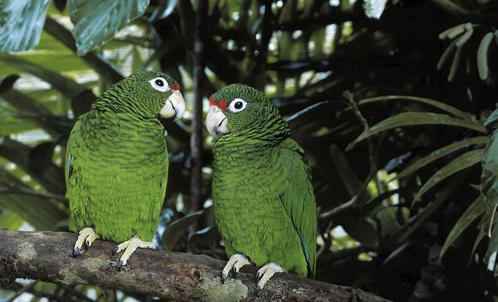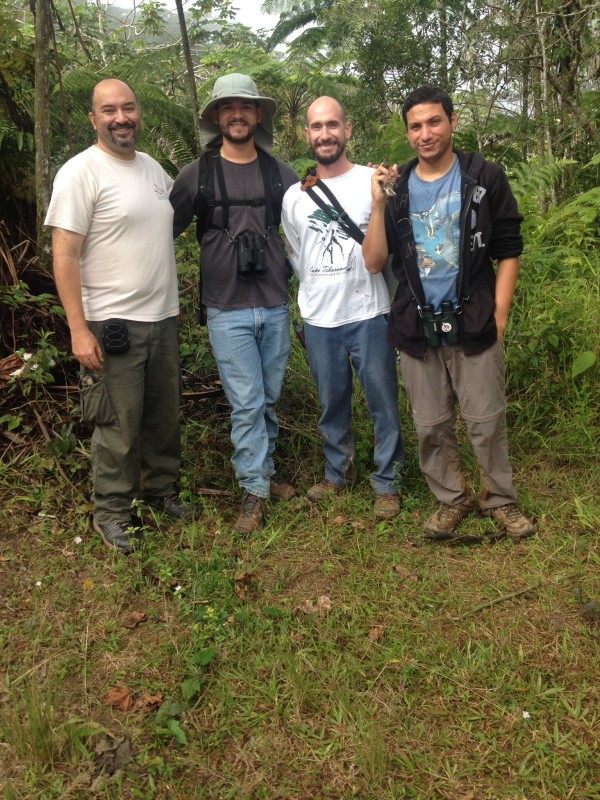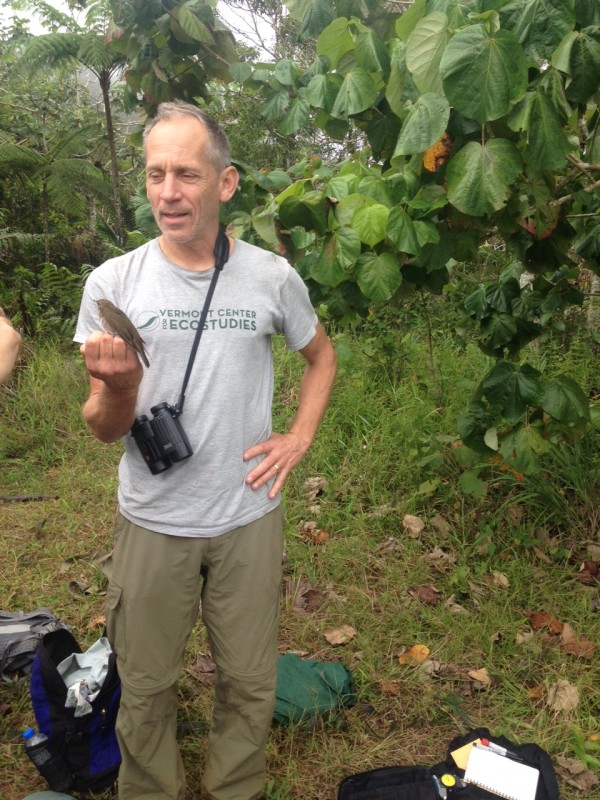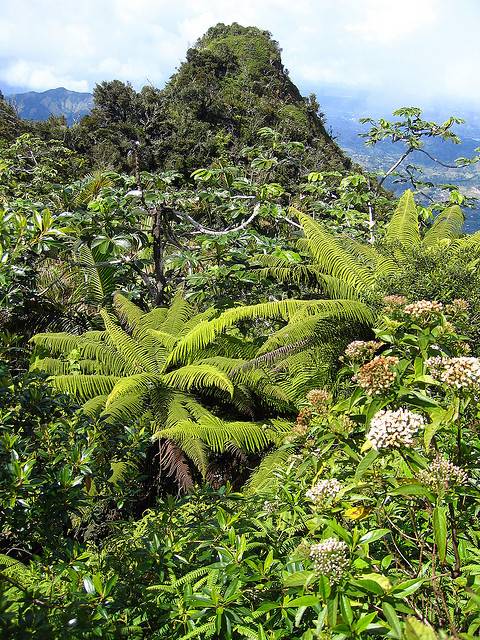
Puerto Rican Parrots, a recovering and federally endangered endemic. Photo courtesy of USDA Forest Service.
Puerto Rican Nightjar? Check — 8 birds calling in the pre-dawn from Guanica’s dry forested hillsides. Elfin Woods-Warbler? Check — 2% of the species’ global population tallied during two mornings in Maricao State Forest. Puerto Rican Tody and Vireo? Check — a dime a dozen in nearly every wooded nook and cranny. Puerto Rico’s 13 other endemics? Check — including a small flock of Puerto Rican Parrots in Rio Abajo, free-flying progeny from the captive breeding population that numbered a mere 13 individuals 40 years ago. Bicknell’s Thrush? Check, but barely — 7 birds begrudgingly showing themselves during a week of intensive surveys, all concentrated in high-elevation forest patches of Cordillera Central.
Midway through Year 2 of VCE’s project to clarify the overwinter status of Bicknell’s Thrush on Puerto Rico, we know far more about distribution and habitat preferences of the island’s 17 endemics than we do about this ever-elusive species. Bicknell’s Thrush just doesn’t give up its secrets easily.
I recently wrapped up a week of field work (and, yes, birding) on Puerto Rico. Having found a grand total of 3 Bicknell’s Thrushes all of last winter, we abandoned our approach of standardized, by-the-book point counts and resorted to all-out, no-holds-barred presence-absence surveys. Show us forest — dry, mesic or wet, karst or serpentine, sea-level or montane —and we’ll survey it. We need to know where Bicknell’s Thrush are on Puerto Rico, or, as it mostly turns out, where they’re not. Puerto Rico is one of four Greater Antillean islands that comprise the species’ entire winter range. Forest habitats on each island are under siege, and conserving Bicknell’s Thrush demands that we fully understand its overwintering status.
With experienced ornithologist José Salguero again leading VCE’s local field team, this winter’s surveys so far have yielded precious few Bicknell’s Thrushes, but more than double our 2015 tally. From Guajataca’s limestone forests along the north coast, to Rio Abajo’s mid-elevation mesic secondary forests, to Maricao’s wet montane serpentine forests, to Guanica parchingly dry forests, our playback broadcasts have met with silence. Only in the island’s highest reaches, along its central spine, in scattered patches of elfin forest at elevations of 4000 feet-plus elevation, have we found our quarry.

The VCE Dream Team on Puerto Rico. From left: Jose Salguero, Fabio Tarazona, Alcides Morales, Julio Salgado (with nist-netted Bicknell’s Thrush)
At dawn on January 28, I hiked up the steep access road of Puerto Rico’s tallest peak, Cerro Punta, at ~4400 feet nearly the exact height as our own Mt. Mansfield. I was alone, the rest of our field team having fanned out below me. As a strong wind whipped clouds across the summit, soaking the stunted trees and swallowing up the ‘peeer’ calls from my handheld speaker, I clambered up to a small overlook and had the extraordinary realization that I was gazing down on an entire island of 4 million people!
I didn’t find a Bicknell’s Thrush on Cerro Punta itself, but over the next two days, we coaxed responses from 5 birds in elfin forest below the peak along sparsely-traveled Rt. 143. We also discovered 2 thrushes in nearby Guilarte State Forest, where we managed to mist net and band a strongly responsive male. This bird occupied a small patch of dense secondary forest with an impenetrable understory of tree ferns, and its capture was a milestone accomplishment for us, undeniable confirmation of the species’ occurrence on the island. The bird’s aggressive behavior and robust body condition suggested that it held a territory and had so far fared the winter reasonably well.

Chris Rimmer with VCE’s first-ever banded Bicknell’s Thrush on Puerto Rico, Guilarte State Forest, 26 January 2016.
Away from Cordillera Central, however, we’ve so far struck out on the Bicknell’s Thrush front, reinforcing our belief that the species is rare and local on the island. José and team will continue field surveys through March, and I’ll be very surprised if they unearth a mother lode of thrushes anywhere, though I expect a few more birds to turn up in the high-elevation elfin forest. Fabio Tarazona and I tried to penetrate one of these forest patches off the road on our final morning, but we were utterly, physically thwarted. The stunted forest — only 3-4 meters tall — made up in density what it lacked in height. I have never been confronted with such an impermeable, tangled maze of vertical and horizontal stems, a montane mangrove forest on steroids! These patches are irregularly scattered, however, and they don’t seem extensive enough to support large numbers of Bicknell’s Thrush overall.
While it’s disappointing not to have yet found more thrushes on Puerto Rico, our findings provide extremely valuable information. For one, they reinforce the huge importance of Hispaniola, in particular the Dominican Republic, to sustain overwintering Bicknell’s Thrushes. With regions like Sierra de Bahoruco under increasing assault from commercial agriculture and charcoal production, VCE and our partners must redouble efforts to conserve those cloud forests. We must also now turn our attention to Cuba and Jamaica, neither of which have been adequately surveyed for Bicknell’s Thrush.
We’re not throwing in the towel on Puerto Rico yet, not by any means, but it seems unlikely that the island will become a major focus of efforts to conserve Bicknell’s Thrush. The habitats in which we’ve found the species are relatively well-protected, and that itself is reassuring. Stay tuned for an end-of-season update.


Thats a good number for puerto rico. In my four years i only saw one east of san juan next to the beach on a october day must have arrived recently. I never taped for them though….
That individual was almost certainly migrating. Did you add it to eBird?
Climate change is accelerating the invasion and replacement of stunted spruce-fir habitat on the high peaks of the Adirondacks and White Mountains where the Bicknell’s breed.